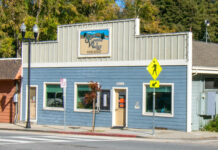On July 13, the Highlands Park Senior Center was teeming with frustrated San Lorenzo Valley residents. Customers of Big Basin Water Company (BBWC) gathered—in-person and virtually—to get updates on the potential receivership being planned for the utility following years of failing infrastructure and fiscal mismanagement.
(A receivership is a remedy provided by the court. A receiver is court-appointed, and they are tasked with bringing the system back into compliance with drinking water laws and regulations.)
Local agencies, including the State Water Resources Control Board (SWRCB) and the California Public Utilities Commission (CPUC), dispatched representatives to better explain the process to the community.
With more than 140 attendees, members of the SWRCB’s Division of Drinking Water (DDW) fielded questions from BBWC customers, the majority of whom had lost their homes in the 2020 CZU August Lightning Complex Fire.
Several in attendance were in the process of rebuilding their homes, with some just waiting for that final water hookup in order to move in. DDW reps confirmed that until the utility either addressed the infrastructure problems or moved into receivership, restoration of water hookups would be declined.
While BBWC water has been tested and currently meets all standards for clean, safe and potable drinking water—the frequent boil orders notwithstanding—the main issue with the utility is its wastewater treatment facility.
According to Attorney Laura Mooney of the State Water Board Office of Enforcement, about 30 parcels in the Fern Rock Way and Cypress Tree Lane neighborhoods receive wastewater service from BBWC.
While the wastewater treatment plan has been without power since the 2020 fire, the relentless storms of the winter further taxed the holding tanks beyond capacity; photos of the BBWC in-ground wastewater tanks showed raw sewage exceeding the lip of the container and saturating the ground; another showed a mosquito breeding habitat with thousands of mosquitos perched atop the mucky green surface of untreated waste.
Mooney stated that her agency learned last fall that, despite the catastrophic failure of the wastewater treatment plant, BBWC wasn’t addressing the issue.
According to Mooney, other wastewater treatment facilities that experience failure use a “pump and haul” method to remove the waste, meaning the material is pumped into a truck and taken to a functioning wastewater treatment facility for proper disposal.
Although that option was available to BBWC, the utility failed to utilize it. Despite applying “progressive enforcement tools” to encourage the BBWC to solve the problem, Mooney stated that the lack of response from the utility had forced her agency to reach out to Rob Bonta, California’s Attorney General, to undertake more formal enforcement actions to demand compliance.
Mooney said that BBWC recently hired a contractor to assist with restoration of the wastewater plant’s operation. That will come as a relief to the utility’s users who have seen raw sewage appear in toilets and bathtubs as alleged in an April report from SWRCB.
Any scenario in which BBWC could address and solve the multitude of issues within its system in a timely manner—if at all—is far-fetched given the severity of the problems and the ensuing price tag; estimates are that it will take nearly $3M to provide critical repairs and bring the facility into compliance.
DDW speakers Stefan Cajina (North Coastal Section Chief) and Jonathan Weininger (Monterey District Engineer) emphasized that their division has been aware of, and working on, this issue for several years, and they had finally reached a point where information could be shared with the public.
The public was none too pleased with what they heard.
Fifth District Supervisor Bruce McPherson, who attended the meeting, was castigated by one attendee for his lack of efforts and response to the issue, and was pointedly asked why the San Lorenzo Valley Water District couldn’t be forced to take over BBWC.
McPherson stated that his office has encouraged the SLV utility to purchase BBWC, but they had opted out.
“I don’t think you should hold that against the SLV District,” McPherson said.
For now, residents are left waiting to hear what will happen to the utility.
Members of the DDW announced there is a potential buyer for BBWC, but that the purchase process would take many months. Residents were warned not to expect any movement toward a purchase or receivership until the end of 2023.













